
Ants are eusocial insects of the family Formicidae and, along with the related wasps and bees, belong to the order Hymenoptera. Ants evolved from vespoid wasp ancestors in the Cretaceous period. More than 13,800 of an estimated total of 22,000 species have been classified. They are easily identified by their geniculate (elbowed) antennae and the distinctive node-like structure that forms their slender waists.

The Formicinae are a subfamily within the Formicidae containing ants of moderate evolutionary development.

Formica rufibarbis is a European formicine ant of the Formica fusca group. In the classification by Auguste Forel, it is treated in the subgenus Serviformica. F. rufibarbis is subject to a Species Action Plan (SAP) in England, where it is known from only two locations, although it is not considered to be at risk on continental Europe.

Formica is a genus of ants of the family Formicidae, including species commonly known as wood ants, mound ants, thatching ants, and field ants. Formica is the type genus of the Formicidae, and of the subfamily Formicinae. The type species of genus Formica is the European red wood ant Formica rufa. Ants of this genus tend to be between 4 and 8 mm long. Ants belonging to the Formica genus possess a single knob or bump located between their thorax and abdomen. These ants primarily feed on honeydew, a sugary liquid produced by aphids. Formica ants appear to take on a shepherding role with smaller aphids, relocating them to different parts of plants to ensure a continuous food source for the aphids. By doing so, the ants can establish a relatively sustainable honeydew supply for both themselves and their colony.

Formica rufa, also known as the red wood ant, southern wood ant, or horse ant, is a boreal member of the Formica rufa group of ants, and is the type species for that group, being described already by Linnaeus. It is native to Eurasia, with a recorded distribution stretching from the middle of Scandinavia to the northern Iberia and Anatolia, and from Great Britain to Lake Baikal, with unconfirmed reportings of it also to the Russian Far East. There are claims that it can be found in North America, but this is not confirmed in specialised literature, and no recent publication where North American wood ants are listed mentions it as present, while records from North America are all listed as dubious or unconfirmed in a record compilation. The workers' heads and thoraces are colored red and the abdomen brownish-black, usually with dark patches on the head and promensonotum, although some individuals may be more uniform reddish and even have some red on the part of the gaster facing the body. In order to separate them from closely related species, specimens needs to be inspected under magnification, where difference in hairiness are among the telling characteristics, with Formica rufa being hairier than per example Formica polyctena but less hairy than Formica lugubris. Workers are polymorphic, measuring 4.5–9 mm in length. They have large mandibles, and like many other ant species, they are able to spray formic acid from their abdomens as a defence. Formic acid was first extracted in 1671 by the English naturalist John Ray by distilling a large number of crushed ants of this species. Adult wood ants primarily feed on honeydew from aphids. Some groups form large networks of connected nests with multiple queen colonies, while others have single-queen colonies.
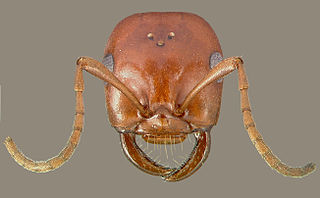
Polyergus is a small genus of ants with 14 described species. They are also referred to by the names "slave-raiding ants" and "Amazon ants". They are characterized by their habit of raiding nests for workers.
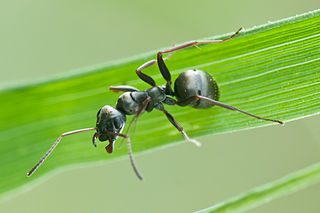
Formica fusca is a black-colored ant commonly found throughout Europe as well as parts of southern Asia and Africa. It has the common names silky ant or dusky ant. The range within the palaearctic region extends from Portugal in the west to Japan in the east and from Italy in the south to Fennoscandia in the north. Populations from North America have been split off as a separate species, Formica subaenescens. F. fusca nests are usually found in rotten tree stumps or under stones in clearcut areas and along woodland borders and hedgerows. The species also often occurs in urban areas, feeding on honeydew secreted by the aphids found on weeds.
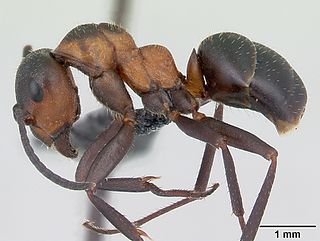
Formica lugubris, also known as the hairy wood ant is commonly found in wooded upland areas across northern Eurasia. Colonies construct large thatched mound nests occupied by thousands of workers, and one or more queens. Workers look similar to other species of wood ants, but Formica lugubris workers can be identified by a fringe of hairs that reaches down to their eyes and prominent hairs between the facets of their compound eyes. Workers can reach sizes of up to 9 mm long; queens are larger, reaching 12 mm long.

Polyergus breviceps is a species of ant endemic to the United States. It is a social parasite of other ants, namely of Formica gnava but also of Formica occulta and Formica argentea. Polyergus is an inquiline parasite, having lost its ability to take care of its young and themselves. "The workers do not forage for food, feed the young or the queen, or even clean up their own nest". To survive, Polyergus workers raid Formica nests to steal the pupae—which, once hatched, become workers of the mixed nest. This sort of relationship is not unique, of the approximately 8,800 species of ants, at least 200 have evolved some form of symbiotic relationship with one another. What makes Polyergus special is the way a newly mated queen can, all by herself, take over a Formica nest and start a new colony.

Polyergus lucidus is a species of slave-making ant in the subfamily Formicinae endemic to the eastern United States. It is an obligatory social parasite, unable to feed itself or look after its brood and reliant on ants of another species of the genus Formica to undertake these tasks. Parasitic ants are known as "dulotics" and the ants they parasitise are known as "hosts".

Rossomyrmex is a genus of slave-making ant in the subfamily Formicinae. The genus consists of four species, each with a single host from the genus Proformica, and has a very wide range of distribution from China to southeastern Spain, from huge extended plains to the top of high mountains.

Formica sanguinea, or blood-red ant, is a species of facultative slave-maker ant in the genus Formica characterized by the ability to secrete formic acid. It ranges from Central and Northern Europe through Russia to Japan, China, the Korean Peninsula, Africa and also the United States. This species is coloured red and black with workers up to 7 mm long.
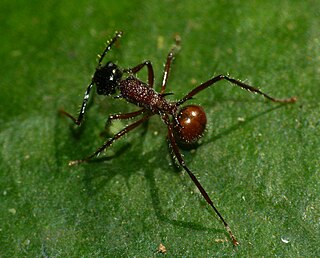
Polyrhachis is a genus of formicine ants found in the Old World with over 600 species. The genus is yet to be comprehensively resolved and contains many varied species including nest-weavers, swimming workers, soil and tree-dwellers. First fossil record of this genus was P. annosa from Miocene.

Slave-making ants or slaver ants are brood parasites that capture broods of other ant species to increase the worker force of their colony. After emerging in the slave-maker nest, slave workers work as if they were in their own colony, while parasite workers only concentrate on replenishing the labor force from neighboring host nests, a process called slave raiding.
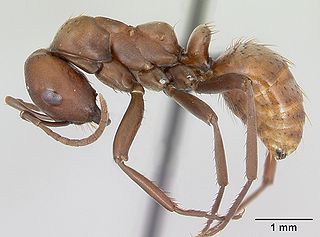
Polyergus rufescens is a species of slave-making ant native to southern Europe and parts of Asia, commonly referred to as the European Amazon ant or as the slave-making ant. It is an obligatory social parasite, unable to feed itself or look after the colony and reliant on ants of another species to undertake these tasks. To replenish these servant ants, it raids nearby ant colonies and carries home pupae and larvae, and these are reared to provide future workers for the colony. A newly mated female P. rufescens needs to make its way into one of these "host" nests, kill the host queen, and be accepted by the host workers in her place.

Polyergus mexicanus is a species of slave-making ant in the subfamily Formicinae. It is the most widely distributed species of Polyergus in North America. It is an obligatory social parasite, unable to feed itself or look after the colony and reliant on ants of another species, Formica, to undertake these tasks. The parasitic ants are known as "dulotics" and the ants they parasitise are known as "hosts".

Formica incerta is a species of ant found in eastern North America. It is the most common species of Formica in many areas, and excavates underground nests with small entrance holes. Its diet includes nectar produced by extrafloral nectaries and honeydew, which it obtains from aphids and treehoppers. It is the main host for the slave-making ant Polyergus lucidus. F. incerta was first described by Italian entomologist Carlo Emery in 1893. Its specific name comes from the Latin incertus meaning "uncertain" and seems particularly apt given the subsequent uncertainty as to the validity of the species and the difficulty in distinguishing this ant from other species living in the same area.

Formica subsericea, colloquially known as the black field ant, is a species of ant in the genus Formica. It is found in the eastern United States and Canada. Workers of this species are incredibly fast and quite timid. Workers of this species are commonly found working as slaves in Polyergus colonies. Nuptial flights typically occur in July or August. It is often confused with another Formica species, Formica fusca. The larvae of Microdon megalogaster, a member of the ant fly genus, have been observed in the nests of these ants. The inquiline relationship of these fly larvae is not well understood.
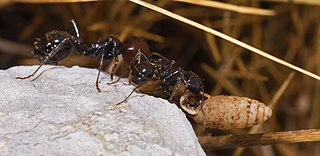
Messor capitatus is an ant species part of the genus Messor. This genus includes about 40 specialized species that are found in dry areas of Mediterranean countries such as Africa, Southern Europe, and Asia. Messor capitatus are known as an Old World species because they release trail pheromones from the Dufour gland instead of from poison glands. Messor capitatus are known as individual foragers that collect food independently of one another but sometimes will also use group foraging to form irregular, broad columns. Messor capitatus main food source is seeds but they also will eat remains of plants and animals.



















